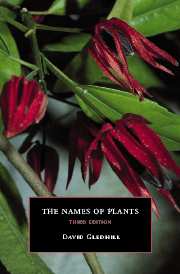Book contents
- Frontmatter
- Contents
- Preface to the first edition
- Preface to the third edition
- The nature of the problem
- The size of the problem
- Towards a solution to the problem
- The rules of botanical nomenclature
- The International Code of Nomenclature for Cultivated Plants
- Botanical terminology
- The glossary
- Addendum to glossary
- Bibliography
The International Code of Nomenclature for Cultivated Plants
Published online by Cambridge University Press: 06 July 2010
- Frontmatter
- Contents
- Preface to the first edition
- Preface to the third edition
- The nature of the problem
- The size of the problem
- Towards a solution to the problem
- The rules of botanical nomenclature
- The International Code of Nomenclature for Cultivated Plants
- Botanical terminology
- The glossary
- Addendum to glossary
- Bibliography
Summary
There can be no doubt that the diverse approaches to naming garden plants, by common names, by botanical names, by mixtures of botanical and common names, by group names and by fancy names, is no less complex than the former unregulated use of common or vernacular names. The psychology of advertising takes descriptive naming into yet new dimensions. It catches the eye with bargain offers of colourful, vigorous and hardy, large-headed, incurved Chrysanthemum cvs. by referring to them as HARDY FOOTBALL MUMS. However, we are not here concerned with such colloquial names or the ethics of mail-order selling techniques but with the regulation of meaningful names under the Code.
In 1952, the Committee for the Nomenclature of Cultivated Plants of the International Botanical Congress and the International Horticultural Congress in London adopted the International Code of Nomenclature for Cultivated Plants. Sometimes known as the Cultivated Code, it was first published in 1953 and has been revised several times at irregular intervals since then (Trehane, 1995). This Code formally introduced the term ‘cultivar’ to encompass all varieties or derivatives of wild plants which are raised under cultivation and its aim is to ‘promote uniformity and fixity in the naming of agricultural, sylvicultural and horticultural cultivars (varieties)’. The term culton (plural culta) is also mooted as an equivalent of the botanical term taxon.
The Cultivated Code governs the names of all plants which retain their distinctive characters, or combination of distinctive characters, when reproduced sexually (by seed), or vegetatively in cultivation.
- Type
- Chapter
- Information
- The Names of Plants , pp. 46 - 53Publisher: Cambridge University PressPrint publication year: 2002



